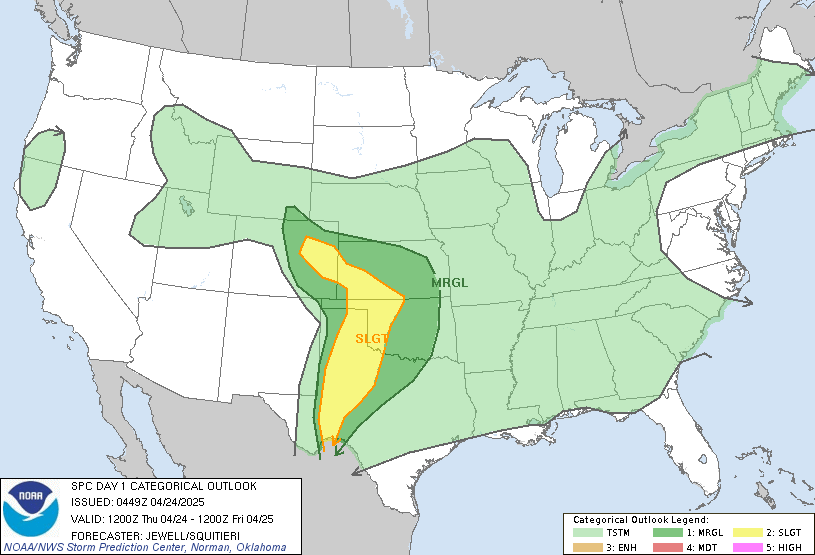LIVE MAP (ABOVE) ... SPC 1200Z Day 1 Outlook
Day 1 Convective Outlook
NWS Storm Prediction Center Norman OK
1251 AM CDT Mon Jul 31 2023
Valid 311200Z - 011200Z
...THERE IS A MARGINAL RISK OF SEVERE THUNDERSTORMS FOR PORTIONS OF
THE SOUTHEAST INTO SOUTHERN VIRGINIA...THE MID-MISSISSIPPI VALLEY
INTO EAST TEXAS AND LOUISIANA...THE CENTRAL HIGH PLAINS AND THE
NORTHERN PLAINS...AND SOUTHERN ARIZONA...
...SUMMARY...
Isolated strong to severe thunderstorms capable of producing large
hail and gusty winds appear possible today across parts of the
northern/central Plains. Additional thunderstorms producing mainly
strong to damaging winds may occur across parts of the lower/mid
Mississippi Valley, coastal Southeast, and southern Arizona.
...Synopsis...
The mid-level flow across the CONUS will amplify today as a ridge
builds across the central CONUS and a trough deepens across the
East. This will result in a tightening height gradient and
strengthening mid-level northwesterly flow across the Mid-Missouri
Valley and vicinity. A mid-level jet streak will round the northern
periphery of the ridge and will overspread the northern Plains this
evening. A convectively enhanced mid-level shortwave trough will
slowly drift around the mid-level anticyclone and should be the
impetus for thunderstorm activity in the central/northern High
Plains this afternoon/evening.
...Southeast into the Carolinas and southern Virginia...
A cold front moved south across the Southeast today. Some residual
moisture remains in the wake of this front early this morning from
the Carolinas into southern Virginia. As temperatures aloft cool
through the day with the amplifying larger scale trough across the
eastern CONUS, sufficient destabilization is expected for scattered
thunderstorm development. The lack of strong heating should mitigate
the overall severe weather threat, but pockets of 2000 to 2500 J/kg
MLCAPE with effective shear around 25 knots may be sufficient for
some multicell clusters capable of some damaging wind gusts.
...Mid-Missouri Valley into Louisiana and eastern Texas...
A severe MCS moving through northern Arkansas this morning is
expected to weaken as it continues south. However, the remnant
MCV/outflow boundary may provide a focus for thunderstorms this
afternoon, particularly on the western periphery where better
mid-level lapse rates will be located. Additional thunderstorms may
form farther north along this frontal zone, perhaps in the vicinity
of the remnant MCV/convectively enhanced mid-level shortwave trough
currently moving through central Nebraska early this morning.
Stronger mid-level flow across this region could provide shear for a
more organized threat, but the combination of cloud-cover concerns
and dewpoints only in the upper 60s in the wake of the Sunday night
MCS will be mitigating factors to a greater severe-weather threat.
Nonetheless, some localized threat may occur within this frontal
zone if strong destabilization can occur beneath the stronger
mid-level flow, however, it is not clear at this time if or where
that may occur.
The greatest threat for severe storms could be late in the period
(06-12Z) as a 30 to 35 knot low-level jet develops across eastern
Kansas and western Missouri with strong low-level isentropic ascent.
Moisture recovery is also forecast during this period with 3000 to
4000 J/kg MUCAPE and effective shear of 45 to 50 knots. This would
potentially support training supercells capable of large hail along
the frontal zone in central Missouri.
...Central High Plains into the Northern Plains...
A convectively enhanced mid-level shortwave trough is expected to
emerge across the central High Plains this afternoon, and lead to
widespread thunderstorm development along the Front Range amid
strong instability and weak upslope flow. However, despite the
favorable environment for thunderstorms, weak shear (20 to 25 knots
per RAP forecast soundings) should mitigate more than a marginal
threat for large hail or severe wind gusts.
Farther north, across eastern Montana and North Dakota, a more
conditional severe weather threat is expected. The building upper
ridge will lead to mid-level warming and subsidence through the day,
but strong heating should erode inhibition by midday. A supercell
wind profile will be present, so if any thunderstorms can develop,
supercells will be the likely storm mode with a threat for large
hail (potentially 2+ inch) and severe wind gusts. However, building
heights and a lack of obvious forcing (other than perhaps a weak
shortwave trough embedded in the northwesterly flow) casts
considerable uncertainty on storm coverage in this region.
...Southern Arizona...
Numerous thunderstorms are expected to develop across southern
Arizona today as 1.5 to 1.75 inch PWAT values are lifted northward
on the western periphery of the mid-level anticyclone. Inverted-v
soundings in the area will support damaging wind gusts with any of
these storms, but a lack of stronger mid-level flow appears to be
the greatest limiting factor to organization and the potential for a
greater severe-weather threat.
..Bentley.. 07/31/2023
Read more CHECK UPDATE ZOOM GRAPHIC
http://dlvr.it/SszLMv
Windy.com Temps | Gusts | WU KORD KPWK |
CLICK for this month's BIG night sky ... | RADAR FULL MAP SCREEN |
|---|
MOBILE DEVICE? Turn sideways. Weather conditions directly above are near Lakefront. Top tabs refer to O'Hare (official).
Archives for the SPC Convective Outlook are updated daily (approximately) with a live map at the beginning of each article. Follow the link at the end of the article to check for current updates on the NOAA/NWS Storm Prediction Center website. Also, see Archives for Chicago's hourly weather data on CARDINAL NEWS Magazine.
CONVECTIVE | TORNADO | WIND | HAIL
O'Hare International Airport KORD
(Arlington Heights South)
Chicago Executive Airport KPWK
(Arlington Heights North)
Monday, July 31, 2023
SPC Jul 31, 2023 0600 UTC Day 1 Convective Outlook
SUNRISE AND SUNSET TIMES IN UTC (if you're not logged in to Google)
CHICAGO UTC-6 during CST (Central Standard Time, e.g., winter)
CHICAGO UTC-5 during CDT (Daylight Savings Time, e.g., summer)
CHICAGO UTC-6 during CST (Central Standard Time, e.g., winter)
CHICAGO UTC-5 during CDT (Daylight Savings Time, e.g., summer)





















